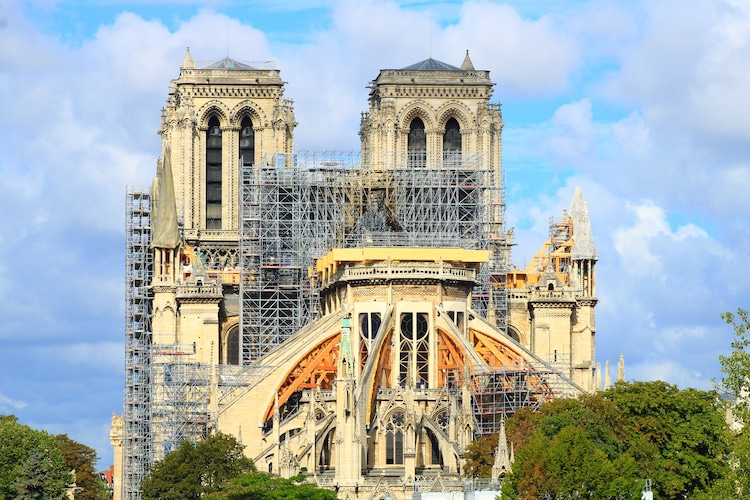Notre Dame – What can be said about this magnificent structure, which hasn’t been said before? Every Architect is fascinated by it’s grand facades, every writer finds inspiration in it’s form, every poet romanticizes its rose windows and every sculptor marvels at it’s flying buttresses. This world-renowned Cathedral, is France’s most famous landmark, an 856 year old structure, reminiscent of the glory of the past and one of the most eminent examples of French Gothic Architecture in the World.
The icon of Christendom, this soaring cathedral built in the heart of Paris, at the Île de la Cité, is dedicated to the Virgin Mary and houses the most famous relics of Christian-ism like parts of the Holy Cross (the real-actual one), one of the nails of the cross and the most famous ‘The Crown of Thorns’. The construction of this iconic structure was started in 1163 in the presence of Alexander III and it was opened to the public in 1345. The Bishop of Paris, Maurice De Sully, had an integral role in the making of the Notre Dame. He oversaw the construction of the main sanctuary and nave of the Cathedral, but nearly died before the main parts were erected. Almost two centuries later, when the cathedral was inaugurated, it had many elements and of the 200 years it took to build, like Gothic features incorporated by many different builders, stained glass windows, spires and buttresses.

The contribution of so many skilled builders and architects, is what makes the Notre Dame a true monument. In 1240, the first known architect of the cathedral, Jean de Chelles, oversaw the construction of the West facade and erected the nave and two towers. His successor, Pierre de Montreuil, can be credited with the construction of the three main Rose windows in the northern, southern and western walls. In order to support the roof and the spires, heavy thick load bearing walls were earlier envisioned. However, to provide more natural light and space for the beautiful rose windows whilst still making the structure steady, Master Architect Jean Ravy employed the famous Gothic Architectural building technique, the flying buttresses in the early 1300s, eventually becoming the most elegant features of the Cathedral.
In 1789, during the French revolution, a lot of the Notre Dame was damaged, with major parts of the facade and roof taking a toll. Nearly 50 years later, Victor Hugo’s famous book, ‘The Hunchback of Notre Dame’ which caught the World’s fancy, inspired a campaign to restore the structure to it’s former glory. 13 years later in 1844, Eugene Viollet-le-Duc was appointed to lead the restoration project. He was responsible in restoring the main west facade and the Gallery of Kings while also adding new elements like a towering spire as well as sculptures of the 12 Apostles (to reinforce the Christian nature of the Notre Dame, which the revolutionaries had dedicated to the cult of the Supreme Being) and also the gargoyles and chimeras placed delicately on the stone walls.

Standing tall for almost another two centuries, tragedy struck on April 15th 2019, when the Notre Dame was engulfed in flames and the World watched heartbroken, the destruction of this age old piece of Art. The fire caused damage to the structure’s roof and the grand spire and a large portion of the cathedral’s ribbed vaulted wooden ceiling. The fire also destroyed some of the stained glass windows and damaged the interiors. Soon after this International tragedy, the art and architecture community erupted in debate about the restoration and redesign of the Notre Dame. Different artists and designers had different opinions about the design, whether it should be rebuilt like it’s old classic version or with a new modern angle, much like the history of the Notre Dame – A collection of the art and architecture techniques of 200+ years.


However, in September 2019, the French Government took a call on this very debate, arguing that a monument needs to be restored in the same exact design as it used to stand in. The French government had put out an International competition for architects and designers to redesign the famous church but it was called off after seeing the modern renditions of the age old cathedral. It was later decided to reconstruct the cathedral, exactly as before, within 5 years.




Such old structures, are witnesses to the changes of mankind. Not only in building science and technology, but of our follies and achievements. Withstanding so many seasons, wars, social and political conflict, modernization and human setbacks, The Notre Dame has a treasure of almost 900 years of our past. The reconstruction of the Notre Dame is not just a matter for the Art and Architecture world to ponder over, but being a cultural and national landmark, it is of significant importance for the French Government and people of the Christian community to come together for the reinstallation of a building marvel.
For more historic pictures and information about the Notre Dame, please visit Natgeo.
